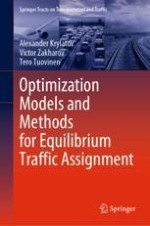This book is focused on the discussion of the traffic assignment problem, the mathematical and practical meaning of variables, functions and basic principles. This work gives information about new approaches, methods and algorithms based on original methodological technique, developed by authors in their publications for the past several years, as well as corresponding prospective implementations. The book may be of interest to a wide range of readers, such as civil engineering students, traffic engineers, developers of traffic assignment algorithms etc. The obtained results here are to be used in both practice and theory. This book is devoted to the traffic assignment problem, formulated in a form of nonlinear optimization program. The most efficient solution algorithms related to the problem are based on its structural features and practical meaning rather than on standard nonlinear optimization techniques or approaches. The authors have carefully considered the meaning of the traffic assignment problem for efficient algorithms development.
